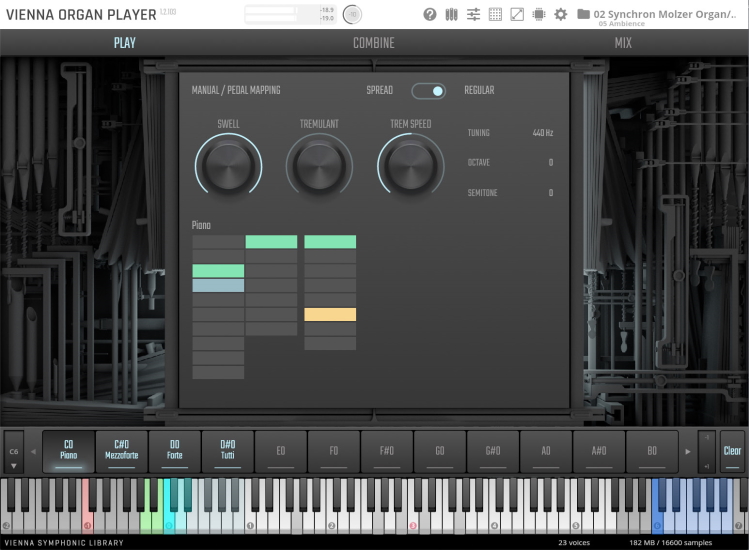Vienna Symphonic Library Synchron Molzer Organ

The Vienna Symphonic Library announces the release of Synchron Molzer Organ, a virtual representation of a historic salon organ recorded on Stage A of Synchron Stage Vienna. It comes with Vienna’s proprietary sample engine and a user interface tailor-made for organ playing, the Vienna Organ Player. The new product is currently available at an introductory price of €75 for the Standard Library (reg. €95), and €145 for the Full Library (reg. €175). The diffference between the Standard Library and the Full Library is the number of available microphone positions.
It is the first time that a historic salon organ was sampled on a scoring stage, enabling it to blend seamlessly with small or large orchestras playing in the same room. Though much smaller than a typical pipe organ, the venerable salon organ is no less blessed with a range of dynamics and colors, capable of both majestic fanfares and quiet reflections. The exceptional acoustics of Synchron Stage’s large hall lend a special transparency to the organ, making it suitable for a variety of styles, from intimate chamber music to large orchestral works and to church music. Using the Synchron Organ Player’s plentiful mixer presets, it can also be used as a solo instrument in all kinds of acoustic environments.
The multiplex organ with 25 stops was built by Ferdinand Molzer in 1938 who at the time was professor of organ building at the University of Music in Vienna. It features two manuals and a pedal board, and three rows of flue pipes: principal, flutes, and strings. Its 267 pipes made of wood, zinc and organ metal alloy range from 10 mm (0.39in) to 2.5 meters (8.2ft) in length.
The Molzer Organ also offers a regular feature of a romantic organ: a crescendo-roller (or roll-sweller) that enables the player to create seamless crescendos from pianissimo to tutti and back by adding or removing registers. Additionally, the organ features four fixed combinations (piano, mezzoforte, forte, tutti) that were masterfully restored and fine-tuned by Austrian organ builder Franz Eisenhut.
For many years the Molzer Organ belonged to pianist and organist Prof. Leopold Marksteiner and was housed in his apartment at Palais Cavriani in Vienna’s first district. Notably, he was the organ teacher of Austrian novelist and playwright, Nobel Prize winner Elfriede Jelinek. The Molzer Organ is now part of the Collection of Historic Musical Instruments at Kunsthistorisches Museum in Vienna.
Vienna’s proprietary organ player virtual instrument affords a lot of flexibility and options. It lets users easily manage the manuals and pedal of the organ so that the different stops are conveniently accessible to create registrations. What’s more, the Vienna Organ Player is multi-timbral so one can address the manuals and pedal via dedicated MIDI channels.
Navigating the player is easy using the three main tabs. The COMBINE tab offers an overview of all the organ’s stops as distributed over the manuals and pedal. The MIX tab lets users access the signals of all seven microphone positions that they can use to create their own sound. The PLAY tab provides access to all parameters that are useful for live playing, including swell (crescendo), tremulant and tremulant speed dials.
Mixer Presets such as Close, Classic, Wide, Church, Leslie, Rock Organ and more make it easy to dial in a variety of sounds, which can also serve as a convenient starting point for the user’s own sonic creations.
A note on performance: The number of used stops and microphone positions can add up to a very high voice count that is likely to overload the CPU. VSL recommends using the preconfigured “Room Mix” presets for live playing and recording into the DAW, and using more microphone signals for rendering an audio track.
 How to resolve AdBlock issue?
How to resolve AdBlock issue? 